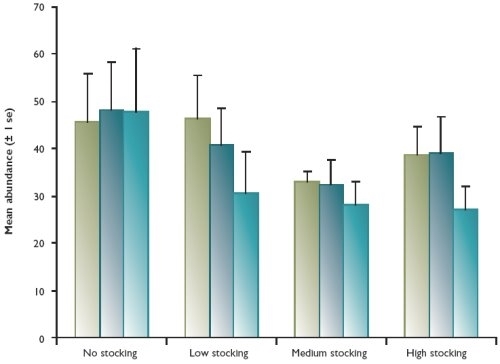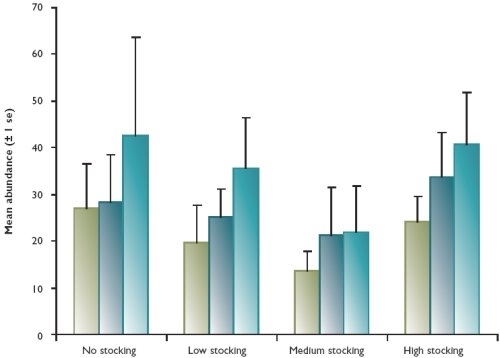Key findings
- There was no statistically signifcant drop in abundance, biomass or growth of wild fish in upland and lowland rivers when stocking took place.
- Stocking did not cause displacement of wild fish in upland or lowland rivers.
- Growth of stocked fish once released was negligible.
- Stocked fish sometimes moved a considerable distance from their release site − mostly downstream.
Farmed brown trout are often stocked into rivers to provide sport for anglers. However, there is concern that such introductions may reduce the viability of wild brown trout populations. Possible impact mechanisms include behavioral interactions, predation effects or genetic interactions. Our study investigated the success of an experimental stocking programme and its affect on the growth and abundance of adult (200mm fork length) wild brown trout over a two year period. We compared non-stocked control sites with stocked treatment sites before and after stocking. We selected 48 sites each of 200 metres long from seven rivers, which represented upland rain-fed rivers and lowland spring-fed chalk streams. Catch and release was normal practice where there was trout fishing.
We used three levels of stocking:
- high – where stocked fish numbers equalled those of adult wild fish;
- medium – where they represented 50% of the wild level;
- low – where their numbers represented 25% of the wild fish.
We replicated these three levels six times for each river category. Average numbers of fish stocked per 200 metres of river for each treatment were: low = 8, medium = 13 and high = 33. Some stocking rates used in fishery management may exceed this range, but a survey of 13 fisheries operating on the study rivers revealed an average stocking rate of 39 fish per 500 metres (16 per 200 metres).
Using electro-fishing, we estimated the abundance of adult wild fish before and after stocking during the summers of 2002, 2003 and 2004. We anaesthetised the brown trout and counted, measured, weighed and marked all those longer than 100mm. We assessed habitat using the HABSCORE index and this did not differ significantly between sites.
We introduced fertile (diploid), mixed-sex stocked fish in spring 2003 and 2004. We used two strains of stocked fish, one from an upland fish farm (strain U; farmed for around 15 years) and another from a lowland fish farm (strain L; farmed for around 30 years). Before stocking we anaesthetised, measured, weighed and individually-marked the pound-sized trout.
We looked at the abundance, growth, biomass and displacement of wild fish, along with the growth and site retention of stocked fish. We also checked the movement of fish between experimental sites and looked at pectoral fin length in the two strains of stocked fish and the wild ones.
Neither abundance, biomass, growth nor the displacement of wild fish were significantly affected by stocking in either upland (see Figure 1) or lowland (see Figure 2) sites in the periods 2002-2003, 2003-2004 and 2002-2004. There was an apparent drop in wild fish abundance at upland sites that were stocked (see Figure 1) – but this was not statistically significant. Wild fish grew very quickly in the lowland rivers, putting on 92% of their initial weight in one particular year – three times that of upland sites.
Figure 1: Abundance of adult (200mm) wild brown trout at upland sites by treatment, 2002-2004

Stocked fish sometimes moved quite long distances (as far as five kilometres upstream and nine kilometres downstream) – most movement was downstream. This phenomenon was not exhibited by wild fish. Only one stocked trout remained in its release site over winter. Wild fish had significantly longer pectoral fins than either of the stocked strains, but strain U had longer fins than strain L. This may be important as fin length probably affects hydrodynamic ability.
The absence of a statistically significant effect of stocking on adult wild trout may be because of the poor performance of the stocked fish, which displayed low growth and quite poor site retention. Laboratory-based experiments also show that wild fish often out-perform farmed fish. The better performance of strain U, its better fin size and the fact that the strain has only been farmed for 15 years suggests that provenance may be an important consideration. However, although improving the performance of stocked fish may seem desirable, it could result in them being more likely to affect wild fish.
Figure 2: Abundance of adult wild brown trout at lowland chalk stream sites

The project was supported by The Game & Wildlife Conservation Trust, The Wild Trout Trust, The British Trout Farmers Restocking Association and members of a variety of angling associations. The work could not be undertaken without the kind permission of the many riparian owners.